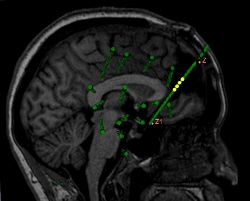New software detects abnormal brain patterns in patients with epilepsy
Presurgical examination is based on identifying the epileptogenic zone (EZ), the area of the brain that needs to be removed for patients to be seizure-free. Until EU research in the EPINET project, there were significant limitations in identifying functional markers to clearly identify the EZ. EPINET researchers have developed a semi-automated strategy for analysing intracranial electroencephalography (iEEG) and magnetoencephalography (MEG) signals in patients with epilepsy. This aspect of the project was conducted by Dr Lucia Quitadamo, the Marie Sklodowska-Curie senior research fellow who translated these efforts into freely available software EPINETLAB. Able to detect high-frequency field oscillations (HFOs), and to quantify their presence in different brain regions, EPINETLAB can delineate the seizure-onset zone. A fully documented, user-friendly platform, EPINETLAB analyses spatio-temporal and frequency characteristics of brain electromagnetic signal outside and during epileptic seizures. “As such, the software can support clinicians in the presurgical workup for the identification of the brain area that needs to be removed in the case of patients affected by refractory or drug-resistant epilepsy,” says Professor Stefano Seri from Aston University, project coordinator. Software development – a two-pronged approach Another aim of the project was to validate the software with both invasive and non-invasive data – iEEG and MEG, respectively. Together, the signals enabled a robust validation of the algorithms involved. Often necessary to identify the source of epileptic activity before surgery, the invasive method, iEEG provided a fundamental means to inspect brain behaviour as pathological HFOs, an EZ biomarker. “iEEG is frequently used when non-invasive diagnostic techniques such as scalp EEG gave non-concordant information on epileptic source localisation,” explains Prof. Seri. For the not-so-experienced end user, EPINETLAB was fully integrated into EEGLAB, a software platform widely used for the analysis of brain electromagnetic data in the neuroscience community. Technicians don’t need high-level programming skills and can easily interact with the software to exploit the general functionalities of EEGLAB and the more specific EPINETLAB ones. Continued data collection “Initially, a database was compiled of iEEG data from 60 patients, collected over three different European centres,” outlines Prof. Seri. These were collected as part of trans-national effort from Niguarda Hospital, and Bambino Gesu’ Hospitals in Italy and the Birmingham Women’s and Children’s Hospital in the United Kingdom. Furthermore, MEG data from 13 paediatric patients was collected during the pre-surgical evaluation at Aston University in children from the Birmingham Children’s Hospital’s Epilepsy Surgery Service. This information enabled the implementation and final validation of EPINETLAB within the project period. “Validation is still an ongoing process as we are gathering a large-scale dataset from international epilepsy centres and adding new functionalities to the EPINETLAB software, as we are aware they are required by end-users,” continues Prof. Seri. Future for EPINETLAB Thanks to the publication in the International Journal of Neural Systems, a highly ranked peer-reviewed journal and dissemination during the International Epilepsy Conference, Barcelona in September 2017, EPINET has gained international visibility. Prof. Seri points out, “EPINET work has led to many collaborations with international institutions to exploit the know-how achieved in the project and to improve the knowledge we have on epilepsy-related issues.” Work with an industrial partner (Micromed S.p.A. Italy), a world leader in the production of systems for neurophysiology, has paved the way to a cross-fertilisation between academia and industry. Together, they explored the possibility of integrating the implemented tools in their diagnostic software package. A strategic objective across the EU, such collaboration will allow consolidation of European leadership in the field. Summarising the importance of project research to the quality of life for the epileptic patient, which is strictly dependent on the level of post-surgery seizure freedom, Prof. Seri concludes, “EPINET has provided epilepsy research for the drug-resistant phenotype with an invaluable means to improve the delineation of the area responsible for the generation of the seizure.”
Keywords
EPINET, software, epilepsy, seizure, iEEG, drug-resistant, EZ







